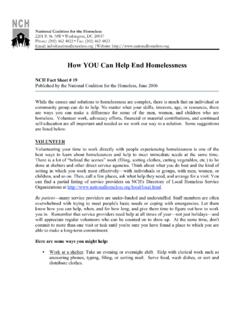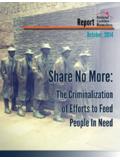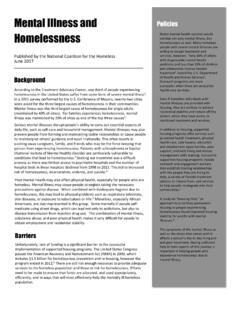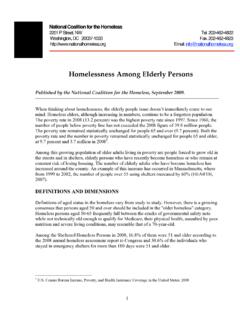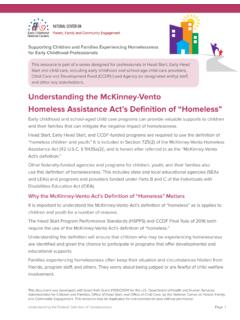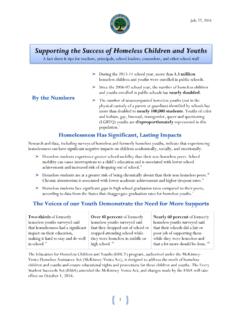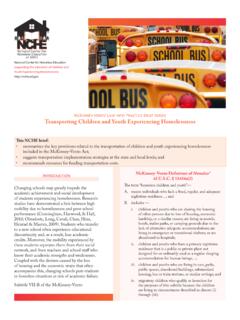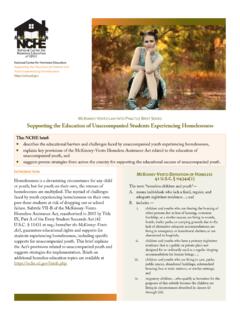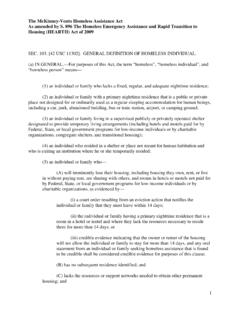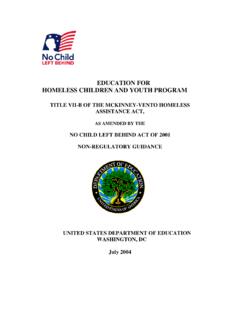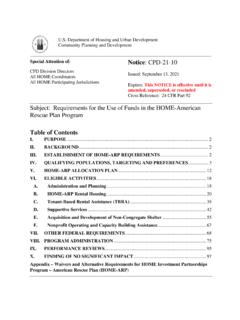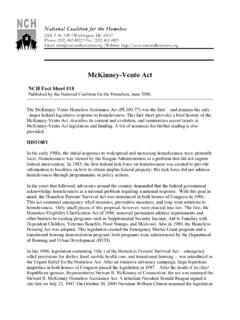Transcription of McKinney-Vento Act - National Coalition for the Homeless
1 McKinney-Vento Act NCH Fact Sheet #18 Published by the National Coalition for the Homeless , June 2006. The McKinney-Vento Homeless assistance Act (PL100-77) was the first -- and remains the only -- major federal legislative response to homelessness. This fact sheet provides a brief history of the McKinney-Vento Act, describes its content and evolution, and summarizes recent trends in McKinney-Vento Act legislation and funding. A list of resources for further reading is also provided. HISTORY In the early 1980s, the initial responses to widespread and increasing homelessness were primarily local. Homelessness was viewed by the Reagan Administration as a problem that did not require federal intervention. In 1983, the first federal task force on homelessness was created to provide information to localities on how to obtain surplus federal property; this task force did not address homelessness through programmatic or policy actions.
2 In the years that followed, advocates around the country demanded that the federal government acknowledge homelessness as a National problem requiring a National response. With this goal in mind, the Homeless Persons' Survival Act was introduced in both houses of Congress in 1986. This act contained emergency relief measures, preventive measures, and long-term solutions to homelessness. Only small pieces of this proposal, however, were enacted into law. The first, the Homeless Eligibility Clarification Act of 1986, removed permanent address requirements and other barriers to existing programs such as Supplemental Security Income, Aid to Families with Dependent Children, Veterans Benefits, Food Stamps, and Medicaid. Also in 1986, the Homeless Housing Act was adopted. This legislation created the Emergency Shelter Grant program and a transitional housing demonstration program; both programs were administered by the Department of Housing and Urban Development (HUD).
3 In late 1986, legislation containing Title I of the Homeless Persons' Survival Act -- emergency relief provisions for shelter, food, mobile health care, and transitional housing -- was introduced as the Urgent Relief for the Homeless Act. After an intensive advocacy campaign, large bipartisan majorities in both houses of Congress passed the legislation in 1987. After the death of its chief Republican sponsor, Representative Stewart B. mckinney of Connecticut, the act was renamed the Stewart B. mckinney Homeless assistance Act. A reluctant President Ronald Reagan signed it into law on July 22, 1987. On October 30, 2000 President William Clinton renamed the legislation N a t i o n a l C o a l i t i o n f o r t h e H o m e l e s s 2201 P. St. NW Washington, DC 20037 Phone: (202) 462-4822 Fax: (202) 462-4823 Email: |Website: the McKinney-Vento Homeless assistance Act after the death of Representative Bruce vento , a leading supporter of the act since its original passage in 1987.
4 CONTENT The McKinney-Vento Act originally consisted of fifteen programs providing a range of services to Homeless people, including emergency shelter, transitional housing, job training, primary health care, education, and some permanent housing. The McKinney-Vento Act contains nine titles: Title I of the McKinney-Vento Act includes a statement of six findings by Congress and provides a definition of homelessness. Title II establishes and describes the functions of the Interagency Council on the Homeless , an independent entity within the Executive Branch composed of the heads of 15 federal agencies. Title III of the McKinney-Vento Act authorizes the Emergency Food and Shelter Program, which is administered by the Federal Emergency Management Agency (FEMA). Title IV authorizes the emergency shelter and transitional housing programs administered by the Department of Housing and Urban Development, including the Emergency Shelter Grant program (expanded from the program created by the Homeless Housing Act in 1986), the Supportive Housing Demonstration Program, Supplemental assistance for Facilities to Assist the Homeless , and Section 8 Single Room Occupancy Moderate Rehabilitation.
5 Title V of the McKinney-Vento Act imposes requirements on federal agencies to identify and make available surplus federal property, such as buildings and land, for use by states, local governments, and nonprofit agencies to assist Homeless people. Title VI authorizes several programs administered by the Department of Health and Human Services to provide health care services to Homeless persons, including the Health Care for the Homeless program, a Community Mental Health Services block grant program, and two demonstration programs providing mental health and alcohol and drug abuse treatment services to Homeless persons. Title VII of the McKinney-Vento Act authorizes four programs: the Adult Education for the Homeless Program and the Education of Homeless Children and Youth Program, both administered by the Department of Education; the Job Training for the Homeless Demonstration Program, administered by the Department of Labor; and the Emergency Community Services Homeless Grant Program, administered by the Department of Health and Human Services.
6 Title VIII amends the Food Stamp program to facilitate participation in the program by persons who are Homeless , and also expands the Temporary Emergency Food assistance Program, administered by the Department of Agriculture. Title IX of the McKinney-Vento Act extends the Veterans Job Training Act. EVOLUTION The current McKinney-Vento Act has been amended four times: in 1988, 1990, 1992 and 1994. These amendments have, for the most part, expanded the scope and strengthened the provisions of the original legislation. In 1988, Congress amended the then mckinney Act with relatively minor changes. The 1988 amendments mostly served to expand eligible activities and to modify the distribution of mckinney funds. The 1990 amendments were more far reaching, altering the majority of programs authorized by the original act. In addition to expanding eligible activities for several mckinney Act programs, a few new programs were created.
7 These included the Shelter Plus Care program, which provides housing assistance to Homeless individuals with disabilities, mental illness, AIDS, and drug or alcohol addiction, and a demonstration program within the Health Care for the Homeless program to provide primary health care and outreach to at-risk and Homeless children. Also in 1990, the Community Mental Health Services program was amended and given a new name: the Projects for assistance in Transition from Homelessness (PATH) program. The 1990 amendments also specified in greater detail the obligations of states and local educational agencies in assuring the access of Homeless children and youth to public education. The amendments also increased the Education of Homeless Children and Youth program's authorization and required states to make grants to local educational agencies for the purpose of implementing the law. The 1992 amendments modified and expanded Title IV of the then mckinney Act, the shelter and housing provisions.
8 Included in these amendments were the creation of "safe havens," or very low-cost shelter for persons unwilling or unable to participate in supportive services; the creation of a Rural Homeless Housing assistance grant program; and the consolidation of the mental health services demonstration program and the alcohol and drug abuse treatment demonstration program into the Access to Community Care and Effective Services and Support (ACCESS) program. The ACCESS demonstration program was designed to fund projects that integrate services for severely mentally ill people. In 1994, Congress amended the Education of the Homeless Children and Youth program and the Surplus Property Program. The amendments to the Education of Homeless Children and Youth program provided local educational authorities with greater flexibility in the use of funds; specified the rights of Homeless preschoolers to a free and appropriate public preschool education; gave parents of Homeless children and youth a voice regarding their children's school placement; and required educational authorities to coordinate with housing authorities.
9 The 1994 amendments also removed military bases closed under base-closure laws from the mckinney Act process and created a new process under which service providers could apply to Local Redevelopment Agencies to use property at closed bases to assist Homeless persons. RECENT TRENDS AND CURRENT STATUS Since the passage of the original mckinney Act in 1987, the now McKinney-Vento Act programs have been expanded and funding has significantly increased. However, McKinney-Vento programs have suffered setbacks in recent years. These programs now face new challenges as homelessness persists unabated across the country. Congress authorized just over $1 billion in expenditures for mckinney Act programs for 1987 and 1988; however, a total $712 million was appropriated for those years. In subsequent years, overall funding levels increased from $ million in FY87 to the all-time high of $ billion in FY95. Recently, however, support for McKinney-Vento Act programs has declined.
10 The share of the budget allocated to Homeless assistance Grants has decreased by 8% over the past four years, and by 28% since 1995, when the Homeless plans were consolidated ( National Law Center on Homelessness and Poverty, 2005). In FY94, the Interagency Council on the Homeless lost its funding and was made part of the White House's Domestic Policy Council. In FY95, funding for the Job Training for the Homeless program was terminated. In FY96, funding for McKinney-Vento programs was cut by a total of 27%. Several McKinney-Vento programs saw their funding eliminated entirely. These programs included the Adult Education for the Homeless program, the Homeless Veterans Reintegration Project, the Emergency Community Services Homeless Grant Program, and the Family Support Centers. Over the past few years, funding has been partly restored to some of these programs, although few have surpassed their FY95 funding levels. Adding to these concerns, the Administration s suggested budget proposes a 36% decline in federal housing assistance by FY2010 (NLCHP, 2005).
